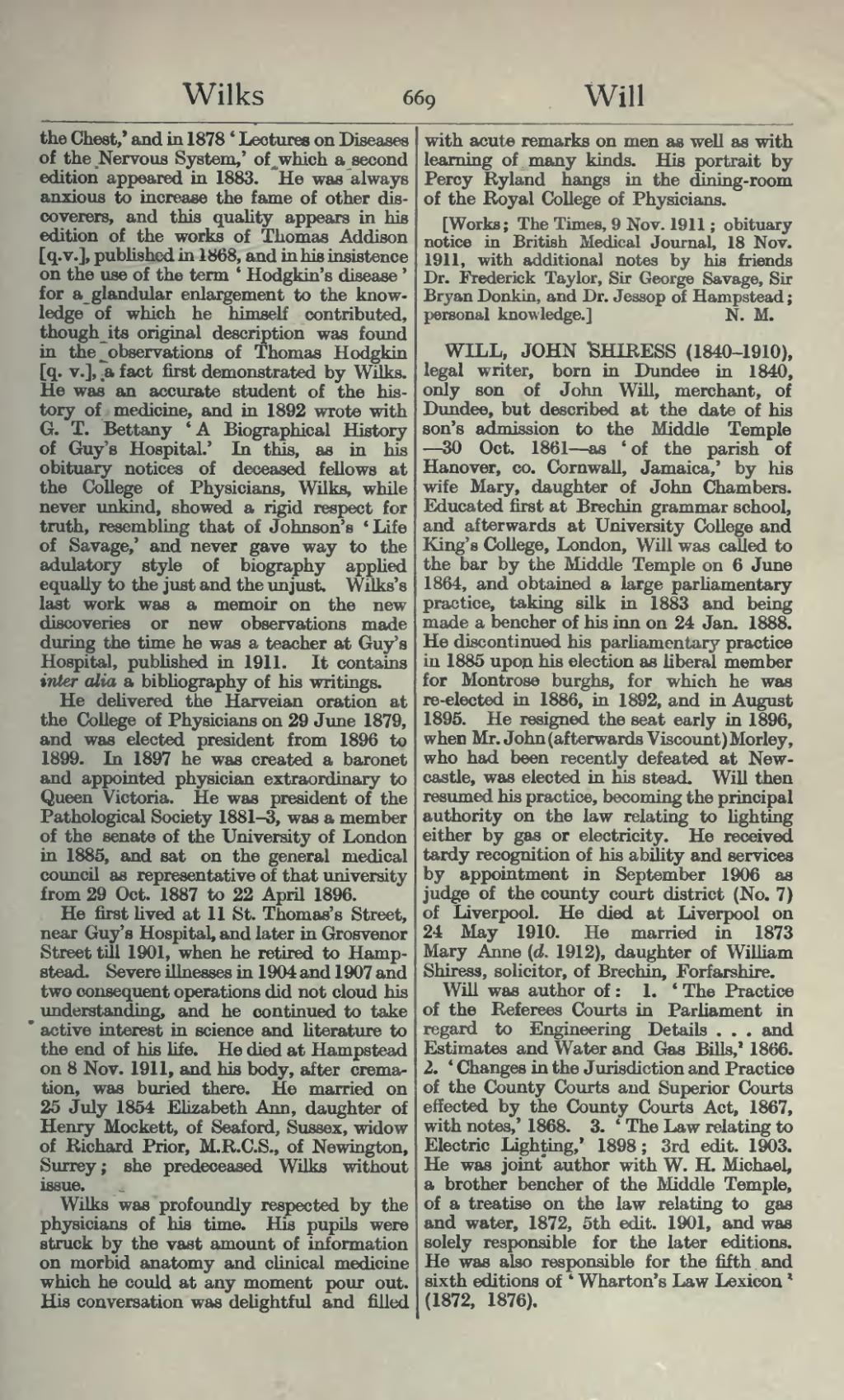the Chest,’ and in 1878 ‘Lectures on Diseases of the Nervous System,’ of which a second edition appeared in 1883. He was always anxious to increase the fame of other discoverers, and this quality appears in his edition of the works of Thomas Addison [q. v.], published in 1868, and in his insistence on the use of the term ‘Hodgkin's disease’ for a glandular enlargement to the knowledge of which he himself contributed, though its original description was found in the observations of Thomas Hodgkin [q. v.], a fact first demonstrated by Wilks. He was an accurate student of the history of medicine, and in 1892 wrote with G. T. Bettany ‘A Biographical History of Guy's Hospital.’ In this, as in his obituary notices of deceased fellows at the College of Physicians, Wilks, while never unkind, showed a rigid respect for truth, resembling that of Johnson's ‘Life of Savage,’ and never gave way to the adulatory style of biography applied equally to the just and the unjust. Wilks's last work was a memoir on the new discoveries or new observations made during the time he was a teacher at Guy's Hospital, published in 1911. It contains inter alia a bibliography of his writings.
He delivered the Harveian oration at the College of Physicians on 29 June 1879, and was elected president from 1896 to 1899. In 1897 he was created a baronet and appointed physician extraordinary to Queen Victoria. He was president of the Pathological Society 1881–3, was a member of the senate of the University of London in 1885, and sat on the general medical council as representative of that university from 29 Oct. 1887 to 22 April 1896.
He first lived at 11 St. Thomas's Street, near Guy's Hospital, and later in Grosvenor Street till 1901, when he retired to Hampstead. Severe illnesses in 1904 and 1907 and two consequent operations did not cloud his understanding, and he continued to take active interest in science and literature to the end of his life. He died at Hampstead on 8 Nov. 1911, and his body, after cremation, was buried there. He married on 25 July 1854 Elizabeth Ann, daughter of Henry Mockett, of Seaford, Sussex, widow of Richard Prior, M.R.C.S., of Newington, Surrey; she predeceased Wilks without issue.
Wilks was profoundly respected by the physicians of his time. His pupils were struck by the vast amount of information on morbid anatomy and clinical medicine which he could at any moment pour out. His conversation was delightful and filled with acute remarks on men as well as with learning of many kinds. His portrait by Percy Ryland hangs in the dining-room of the Royal College of Physicians.
[Works; The Times, 9 Nov. 1911; obituary notice in British Medical Journal, 18 Nov. 1911, with additional notes by his friends Dr. Frederick Taylor, Sir George Savage, Sir Bryan Donkin, and Dr. Jessop of Hampstead; personal knowledge.]
WILL, JOHN SHIRESS (1840–1910), legal writer, born in Dundee in 1840, only son of John Will, merchant, of Dundee, but described at the date of his son's admission to the Middle Temple—30 Oct. 1861—as ‘of the parish of Hanover, co. Cornwall, Jamaica,’ by his wife Mary, daughter of John Chambers. Educated first at Brechin grammar school, and afterwards at University College and King's College, London, Will was called to the bar by the Middle Temple on 6 June 1864, and obtained a large parliamentary practice, taking silk in 1883 and being made a bencher of his inn on 24 Jan. 1888. He discontinued his parliamentary practice in 1885 upon his election as liberal member for Montrose burghs, for which he was re-elected in 1886, in 1892, and in August 1895. He resigned the seat early in 1896, when Mr. John (afterwards Viscount) Morley, who had been recently defeated at Newcastle, was elected in his stead. Will then resumed his practice, becoming the principal authority on the law relating to lighting either by gas or electricity. He received tardy recognition of his ability and services by appointment in September 1906 as judge of the county court district (No. 7) of Liverpool. He died at Liverpool on 24 May 1910. He married in 1873 Mary Anne (d. 1912), daughter of William Shiress, solicitor, of Brechin, Forfarshire.
Will was author of: 1. ‘The Practice of the Referees Courts in Parliament in regard to Engineering Details … and Estimates and Water and Gas Bills,’ 1866. 2. ‘Changes in the Jurisdiction and Practice of the County Courts and Superior Courts effected by the County Courts Act, 1867, with notes,’ 1868. 3. ‘The Law relating to Electric Lighting,’ 1898; 3rd edit. 1903. He was joint author with W. H. Michael, a brother bencher of the Middle Temple, of a treatise on the law relating to gas and water, 1872, 5th edit. 1901, and was solely responsible for the later editions. He was also responsible for the fifth and sixth editions of ‘Wharton's Law Lexicon’ (1872, 1876).
